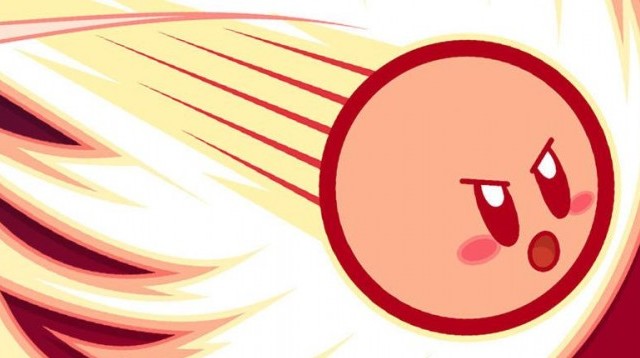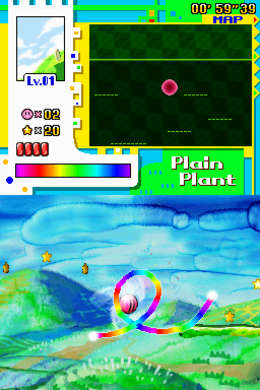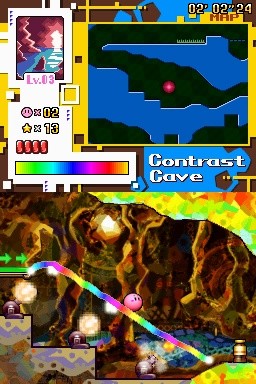
Kirby: Canvas Curse for Nintendo DS is something of an anomaly. The game’s composition is so alienated from the natural Kirby formula, what with the touch controls, the techno arrangements of classic series tunes, and the blending of cartoony, rotund characters against surreal backgrounds that ranged from watercolor valleys to abstract compositions. It didn’t light the sales charts on fire like the numerous versions of Nintendogs, but the game was met with raving success among critics and even non-Kirby fans. Many considered it to be the first real success of the two-screen handheld, as it proved the touch screen could give birth to compelling, unique game design.

Kirby, chasing after an art-crazy witch who deprived him of movement, coasts along rainbow-colored lines drawn by the player’s stylus, and the objective is to guide him through a series of perilous levels all the while conserving a set amount of rainbow ink to tap from. This setup is why our pink hero often finds himself suspended in mid-air, and with the rainbow lines being erased upon every brush of the stylus, it’s not uncommon to desperately juggle Kirby above a bottomless pit thanks to a nearly-depleted ink bar. Such challenge is hardly found in many Kirby titles, and I imagine those turned off by the series’ frequent ease welcomed Canvas Curse‘s pressure with open arms.
What I’ve always found amazing about Canvas Curse is that even though the touch controls demand intense concentration, the overall aesthetic and music direction induce a mellowing calm into the player. This is felt instantly when the game opens with a subdued arrangement of the Kirby 64 menu theme, easing the player into a relaxed state. Kirby has experimented with many different forms of art and sound throughout its lifetime, but Canvas Curse frequently experiments with gorgeous abstract backdrops and coolly compresses the peppy tone of familiar songs such as Cocoa Cave and Castle Lololo to the extent where it forges an offbeat identity separate from the entire series.
Does the game still engage in fun songs and lighthearted antics? Certainly, but this low-key mood permeates the entire game to the point where I can’t be bothered to grow frustrated at its perpetual difficulty. No matter how many hidden medals I miss or how many times I fall prey to the same spike pit, my eyes and ears remain on autopilot, coasting along just like Kirby in this surrealism-based world. In a way, it’s as if the game relishes its independence from the series; when playing the Jump Game, for example, it projects on the system’s top screen a vintage, monochrome film of the original Dream Land setting, hosting a crowd of Kirbies performing the signature Kirby dance as the limbless Kirby simply bounces up and down. Canvas Curse remembers to pay tribute to the Kirby games of old, but puts top priority in establishing its own successful niche.

But for all its differences, Canvas Curse remains careful in adhering to certain series laws. Kirby’s copy abilities remain present, obtained via dashing through enemies and activated by simply tapping Kirby. Be it demolishing enemies (Spark’s summoning of a massive, skyward thunderbolt has to be seen to be believed), clever interactions with the stylus-operated rainbow lines (such as how Stone, Wheel, and Needle all affix themselves to and ride upon them in their own unique way), or plowing through a vast assortment of star blocks (a Kirby staple), Canvas Curse‘s application of copy abilities remains one of the finest yet in the series.
Of course, any talk of Canvas Curse isn’t complete without showcasing the game’s wonderful soundtrack. Just listen to the Rainbow Resort arrangement; it’s every bit as grand and euphoric as the original Kirby’s Adventure track, but its dive into the techno realm grants it an air of melancholy. Such dreamy, reflective tunes were occasionally present in earlier Kirby titles as well, and never failed to provide a stunning contrast to their meaty cheeriness. For Canvas Curse to channel that late-game rapture in the Frozen Fantasy level always steals the show for me, and it remains my favorite portion of the game.
Perhaps the real success of Kirby: Canvas Curse lies not in what the game did for Nintendo DS, but in proving the series’ experimental use. True to the protagonist’s origins, Kirby is as malleable as what’s required of him, and ever since we’ve seen him adorned with yarn, split into ten, and as of last week, stars in an adorable clay-filled adventure that just so happens to be this game’s sequel. If you’ve read our site’s review, you know that Canvas Curse‘s legacy is well preserved within the Wii U’s Kirby and the Rainbow Curse.




 ShareThis
ShareThis






